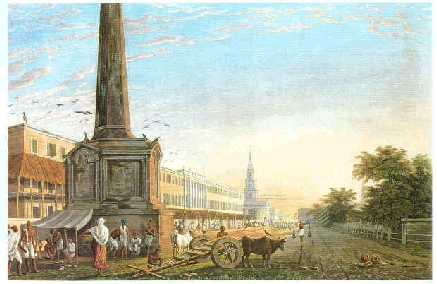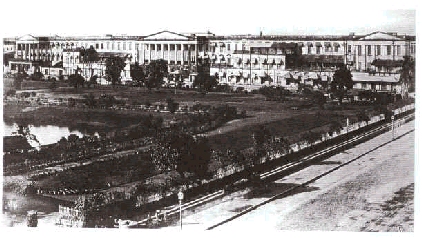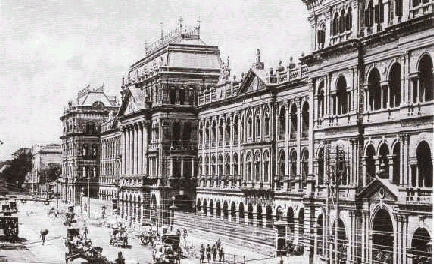 |
Ship me somewheres east of Suez, where the best is like the worst, Where there aren't no Ten Commandments an' a man can raise a thirst (Browning, Ed., 1982: 141).
Rudyard Kipling, possibly the most famous product of the British occupation in India, was adept at capturing the anticipation of a journey to the southern tips of Asia. Born in Bombay in 1865, Kipling experienced life during the territorial zenith of the Raj or British rule, in India. Through his writing he helped exoticize a country of seemingly interminable resources and visual splendor (Encarta '98 Encyclopedia, 1997: "Kipling"). The philosophical demarcation between the East and the West has captured the imagination of scholars for centuries and the study of architecture in India presents an opportunity to analyze these opposing concepts without an ocean to divide them (Said, 1979: 14).
The process of studying India's history employs many tools: censuses, documents, oral histories, memoirs and literature, to name but a few (Crowley, 1988: 25). The art historian is aided in historical scholarship through the study of pieces or structures, which can then be interpreted as symbols of a period or movement to achieve a principal purpose; namely, to create meaning.
This essay will discuss the notion of using an architectural structure as a symbol for the public intentions of its architects. It will achieve this goal through the study of one building germane to the study of the Raj in India-the original Writers' Building in Calcutta, India (c.1797). A brief summary of the occupation of India will create the contextual setting for the ensuing discussion. The available data regarding the structure, the location, the patronage, the purpose, the style, the builders and the subsequent structures of the Writers' Building, will be analyzed in order to support the concept that this building epitomizes the intentions of the British in India during the eighteenth century.
The British were not the first conquerors of India. Rather, they served as the final antagonist in an eight hundred-year drama of occupation beginning with the Muslims. Mughals, Afghans, Portuguese, and Dutch groups each had carved a piece of India for themselves by the sixteenth century. It was the last day of the sixteenth century when the British East India Company received its charter from Queen Elizabeth I to begin exploiting what others had been capitalizing on for centuries (Moorehouse, 1983: 25). And so the "John Company" embarked on their own journey to place the resources and visual splendors of India within their firm grasp (Pal and Dehejia, 1986: 225). The eighteenth century marked the ascent of the East India Company from merchants to imperialists and the proof of this rise can be found within the built realm of India (Moorehouse, 1983: 27).
Marilyn Stokstad's Art History defines architecture as "...three dimensional...highly spatial...[and] closely bound up with developments in technology and materials..." (1995: 31). What this definition lacks is the inclusion that architectural compositions are tangible, physical representations of its builders and their ideas. To find meaning within a structure is to find meaning within a society.
The East India Company commissioned the original Writers' Building to be constructed in one of the three major commerce centers of India. Bombay, Madras and Calcutta, known as the "Presidencies of British India", each served a specific mercantilistic function and as such became the footholds for the East India Company's rise to commercial domination (Pal and Dehejia, 1986: 22). Calcutta's geographical situation, the shores of the Hoogly River, offered deep ports, warehouse space and transportation routes to Europe through the Bay of Bengal (Encarta Encyclopedia 1997, "Calcutta"). In Philip Davies' chapter on Calcutta, suitably titled, "Power on Silt", he discusses an indispensable amenity which the burgeoning town had in abundance-fresh water. The Great Tank is a spring-fed natural reservoir and this feature, for reasons both aesthetic and practical, has incredible value for this study (1985: 47). Calcutta's town common surrounded the reservoir, and so the convenience of Tank Square secured it as the site of Writers' Building (Morris, 1983: 95). The East India Company recognized the practicality and the potential for expansion in choosing this site for their building. Further, the Great Tank provided a visually engaging scene. This declaration of proficiency in terms of choice in location leads to the next focus, which discusses who the patrons were and why the structure was erected to begin with.
The East India Company was one of the first successful joint-stock companies with a board of directors selected from the many stockholders to serve as the administrative body (Encarta '98 Encyclopedia 1997, "English East India Company"). It would be easy for the modern student to posit that the organization of the company was corporate in nature. In other words, a company designed as a group of mere investors and wholesalers with no connection to or participation with existing political foundations of their elected investment focus. This assumption would be ill founded, indeed. Although the East India Company was essentially an investments firm the practical applications of acquiring and securing investments in India was achieved through a militaristic organization (Morris, 1983: 99). Those who travelled to India sought out investments and reported to the board of directors, were by and large soldiers hired to ensure little native resistance. The actual ranking system within the company was in military terms: privates, corporals, lieutenants, etc. (Morris, 1983: 84). It is important to remark that the East India Company not only served as patron to Writers' Building, but also became the major patrons in subsequent, more elaborate building programs, the results of which can still be seen in present day India.
Examining the function of the Writer's Building is vital to the discovery of its significance to its society. As Spiro Kostof explains, the study of architecture finds "...its truth in its use" (1995: 3). The purpose of the Writers' Building was to house the company clerks, or writers, simultaneously serving as a training center for future clerks. The Writers' Building was essentially the barracks for the John Company's office soldiers (Kostof, 1995: 94). This militaristic system not only determined the form of organization the East India Company utilized in their ascent to wealth and success, but it is also notably important to the style of architecture produced in the early Raj period.
To determine the style, one must first observe the manner by which construction occurred. The building program in Calcutta during the middle to late eighteenth-century was based on necessity. If a warehouse was needed, one was built. If a house was needed, one was built, and so on (Davies, 1985: 12). Although British settlers complained of there being no coherent plan to the expansion of Calcutta, a town map shows the forethought of positioning streets and dwellings so as to better capture the cooling winds from the river. Military engineers provided the plan, the design and the execution of the expansion of Calcutta. Simply, they were the only available architects (Morris, 1983: 93).
This actuality aids the art historian in the analysis of the Writers' Building in terms of style. Jan Morris describes it best:
Its nineteen sets of apartments, all identical, were contained in a very long, very solid three-storey block, classical in style, with fifty-seven sets of identical windows, a flat roof and a central projection with Ionic columns (1983: 95).
Although the building in its original form no longer exists, the recounting of the structure's appearance can be supported through artists' renderings, which are contemporaneous to the original edifice.
 |
The significance of this rather "uninspiring" building is found within the classical style; it marks one of the few attempts at large-scale, classically motivated architecture in India (Davies, 1985: 56). It has been suggested that the rather somber motif had been implemented in an effort to assuage the problems encountered by the supervisors of the young, and sometimes rowdy, clerks (Morris, 1983: 95). More aptly stated, a mature environment breeds mature inhabitants.
One might wonder 'To whom is this theory accredited?' Unfortunately the East India Company did not have the ability to see into the future and prepare the answers for the questions art historians ask. Although it has not been proven, the Writers' Building has been attributed to Thomas Lyon, a man who sailed to Calcutta from England to teach carpentry to native labourers. This form of architecture, however, did become the norm and was quipped "The Company Style" (Morris, 1983: 95).
It follows that from the illustrations and descriptions of the Writers' Building, it was not the intention of the East India Company at this stage in their existence to create what Morris calls, "diagrams of supremacy" or grand structures meant to represent hegemony over the natives (Morris, 1983: 84). Rather, the intention of this Classical, reserved style was for the sole benefit of the British stationed in Calcutta, therefore, tracking the motivations of the society at large. In other words, the modus operandi of the civilization, rendered through their architecture, was not to rule but to profit.
The notion of the Writers' Building embodying a more utilitarian, as opposed to a representative function is further supported through an examination of the subsequent Writers' Buildings. As more and more British settlers came to enjoy heightened lifestyles found in India-its relatively low cost of living, the opportunity to have servants and the increased possibility of gainful employment (Lochner 1999: Lecture Notes)-citizens of Calcutta began to complain that the Writers' Building seemed like a "...shabby hospital" (Morris, 1983: 95). Efforts were therefore made to raise the image, not only of the buildings in India, but the British occupation of India, to a grander scale.
Lyon's original design was hidden beneath two phases of facades. The first, in the mid-nineteenth century, was an endeavor to simply embellish the pre-existing structure with low pediments
 |
The second, in the late nineteenth century, proved to be a more ambitious enterprise. The huge building, once classical in style, was transformed to create a Victorian impression, complete with terracotta dressings, dummy portico and pediment, with a Corinthian facade. Thus, the shifting intentions of the British in India changed the appearance of their built environment. The building program was making a definitive statement.
This is where the phrase "diagrams of supremacy" becomes more than appropriate; it becomes germane. Had the Writers' Building been left as it was originally designed the argument of architecture symbolizing societal mores would become moot, however, it was not left untouched and can therefore become supportive of the aforementioned premise.
 |
The significance of the study of British architecture in India has not gone undetected by other scholars and the major theme was adroitly characterized within the title of a text devoted to the period - From Merchants to Emperors (Pal and Dehejia, 1986: 22).
In closing, it is important to mention that the study of the history of western architecture is usually limited to areas within the western realm. This concept can be encapsulated in yet another Kipling poem:
Oh, East is East, and West is West, and never the twain shall meet, Till Earth and Sky stand presently at God's great Judgment Seat (Browning, Ed. 1982: 140)
One could argue that for our purposes, this rhyme seems erroneous for India becomes a perfect example of west meeting east and the legacy of this is found within her architecture (Winchester, 1997: 47). Or is it? Perhaps the Writers' Building in Calcutta, throughout its various aesthetic phases, is and example of the west attmepting to bring upon to the landscape of the east, remoldel it to suit European taste. If they were indeed, meeting the east, they may have appropriated the local architectural styles rather than impose their own.
This essay has argued that architecture, even in the simple, undemonstrative form of the Writers' Building, is a symbol of the societal intentions of a civilization. This was achieved through the examination of the circumstances leading to the commissioning of the building-the development and needs of the British East India Company in their effort to secure profitable investments. The development of the Company Style was traced to the situation that determined it; namely, military engineers as architects. The location of the Writers' Building, both in its significance to the East India Company and in its importance to sustain the Calcuttan community at large, was addressed to show the forethought in urban planning. Finally, the two subsequent transformations of the Writers' Building illustrated the importance of the evolution from function to form. It was delineated to show the shift in purpose-the shift in representation. Simon Winchester's passionate commentary on the visual legacies of British rule in India solidifies the final focus of this study in his own interpretation of the surviving buildings of the Raj:
The British had the idea, when they built grand buildings in India, that the very grandeur might help preserve the institutions they housed once the British had departed, as they knew they one day would. ...All seem to say, monumentally, Keep me as I am (Winchester, 1997: 51)